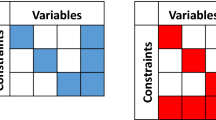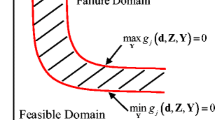Abstract
In matrix-based modeling, a design problem is represented by a rectangular matrix that captures the dependency relationships between design functions and parameters. To decompose such a matrix-based design problem, the two-phase method, which adapts hierarchical cluster analysis, has been proposed in literature. Yet, the clustering strategy in general is still challenging since the decomposition of design problems requires simultaneous clustering of two types of objects (i.e., design functions and parameters). In this paper, the notion of coupling is advanced by characterizing the coupling between two objects of different types. Accordingly, the two-phase method is revised via two methodical components: coupling-based dependency analysis and tree-based partitioning analysis. While the coupling-based dependency analysis concatenates different types of coupling for organizing the dependency structure, the tree-based partitioning analysis utilizes the coupling information from dependency analysis to identify design sub-problems and their interactions. Due to a better understanding of the coupling notion, the revised approach is able to simplify the algorithmic procedure and narrow down the solution search space without compromising the solution quality. Two examples (i.e., a relief valve system and a powertrain system) are used to demonstrate and justify the utility of the revised method.















Similar content being viewed by others
References
Browning TR (2001) Applying the design structure matrix to system decomposition and integration problems: a review and new directions. IEEE Trans Eng Manag 48(3):292–306
Chen L, Li S (2005) Analysis of decomposability and complexity for design problems in the context of decomposition. ASME J Mech Des 127(4):545–557
Chen L, Ding Z, Li S (2005a) A formal two-phase method for decomposition of complex design problems. ASME J Mech Des 127(2):184–195
Chen L, Ding Z, Li S (2005b) Tree-based dependency analysis in decomposition and re-decomposition of complex design problems. ASME J Mech Des 127(1):12–23
Cramer E, Dennis J, Frank P, Lewis R, Shubin G (1994) Problem formulation for multidisciplinary optimization. SIAM J Optim 4(4):754–776
Danilovic M, Browning TR (2007) Managing complex product development projects with design structure matrices and domain mapping matrices. Int J Project Manage 25(3):300–314
Everitt B, Landau S, Leese M, Stahl D (2011) Cluster analysis, 5th edn. Wiley, West Sussex
Fernandez C (1998) Integration analysis of product architecture to support effective team co-location. Master of Science thesis, Massachusetts Institute of Technology, Cambridge, Massachusetts
Garey MR, Johnson DS (1979) Computers and intractability: a guide to the theory of np-completeness. Freedman, New York
Hauser J, Clausing D (1988) The house of quality. Harvard Business Rev 66(3):63–73
Kannapan SM, Marshek KM (1992) An approach to parametric machine design and negotiation in concurrent engineering. In: Kusiak A (ed) Concurrent engineering: automation, tools, techniques. John-Wiley, New York, pp 509–533
Kim HM, Michelena NF, Papalambros PY, Jiang T (2003) Target cascading in optimal system design. ASME J Mech Des 125(3):474–480
King JR (1980) Machine-component group in production flow analysis: an approach using a rank order clustering algorithm. Int J Prod Res 18(2):213–232
Krishnamachari RS (1996) A decomposition synthesis methodology for optimal systems design, PhD Thesis, Department of Mechanical Engineering and Applied Mechanics, University of Michigan, Ann Arbor, MI
Krishnamachari RS, Papalambros PY (1997) Optimal hierarchical decomposition synthesis using integer programming. ASME J Mech Des 119(4):440–447
Kusiak A (2000) Computational intelligence in design and manufacturing. Wiley, New York
Kusiak A, Cheng CH (1990) A branch-and-bound algorithm for solving the group technology problem. Ann Oper Res 26:415–431
Kusiak A, Chow WS (1987) Efficient solving of the group technology problem. J Manufact Syst 6(2):117–124
Kusiak A, Wang J (1993) Efficient organizing of design activities. Int J Prod Res 31(4):753–769
Li S (2010) Methodical extensions for decomposition of matrix-based design problems. ASME J Mech Des 132(6):061003
Lindemann U, Maurer M, Braun T (2009) Structural complexity management: an approach for the field of product design. Springer, Berlin
McCord KR, Eppinger SD (1993) Managing the integration problem in concurrent engineering, Working Paper No. 3594, MIT Sloan School of Management, Cambridge, Massachusetts
McCormick WT Jr, Schweitzer PJ, White TW (1972) Problem decomposition and data reorganization by a clustering technique. Operat Res 20(5):993–1009
Michelena NF, Papalambros PY (1995) A network reliability approach to optimal decomposition of design problems. ASME J Mech Des 117(3):433–440
Michelena NF, Papalambros PY (1997) A hypergraph framework for optimal model-based decomposition of design problems. Comput Optim Appl 8(2):173–196
Pimmler TU, Eppinger SD (1994) Integration analysis of product decompositions, Proceedings of ASME 6th International Conference on Design Theory and Methodology, Minneapolis, Minnesota
Prasad B (1997) Concurrent engineering fundamentals, vol I & II. Prentice Hall, New Jersey
Romesburg HC (2004) Cluster analysis for researchers. Lulu Press, North Carolina
Schloegel K, Karypis G, Kumar V (2003) Graph partitioning for high-performance scientific simulations. In: Dongarra J et al (eds) Sourcebook of parallel computing. Morgan Kaufmann Publishers, San Francisco
Shannon CE (1948) A mathematical theory of communication. Bell Syst Tech J 27:379–623
Steward DV (1965) Partitioning and tearing systems of equations. J SIAM: Ser B Num Anal 2(2):345–365
Suh NP (1990) The principle of design. Oxford University Press, New York
Summers J, Shah J (2010) Mechanical engineering design complexity metrics: size, coupling, and solvability. ASME J Mech Eng 132(2):021004
Wasserman S, Faust K (1994) Social network analysis: methods and applications. Cambridge University Press, New York
Weil RL, Kettler PC (1971) Rearranging matrices to block-angular form for decomposition (and other) algorithms. Manage Sci 18(1):98–108
Yu T, Goldberg D, Sastry K, Lima C, Pelikan M (2009) Dependency structure matrix, genetic algorithms, and effective recombination. Evol Comput 17(4):595–626
Acknowledgments
The anonymous reviewers are acknowledged for their valuable comments to improve the quality of the paper.
Author information
Authors and Affiliations
Corresponding author
Appendix: Steps of hierarchical cluster analysis
Appendix: Steps of hierarchical cluster analysis
This appendix explains the basic steps of the single linkage clustering method (one type of hierarchical cluster analysis) that is used in the revised two-phase method of this paper. Particularly, the method takes a coupling matrix as the input and yields the tree (or dendrogram) as the output. The algorithmic procedure is based on Romesburg (2004). The coupling matrix shown in Table 4 is used for illustration.
Step 1: Pick two objects that yield the highest value in the coupling matrix. In this case, objects c and d have the highest coupling value (i.e., 0.92). Thus, these two objects are picked.
Step 2: Form the branch of the tree by combining the picked objects, as shown in Fig. 16. The vertical axis of Fig. 16 is labeled with the coupling values. The newly formed branch combines two objects at their coupling value. For instance, objects c and d are combined at the coupling value of 0.92 in Fig. 16. The newly formed branch is labeled as ‘cd’.
Step 3: Update the coupling matrix to represent the newly formed branch. Such modification is achieved through the average distance formulation as follows.
where r ik is the coupling value between objects i and k in the coupling matrix, and the subscript ij is referred to the newly combined branch. Table 5 has shown the updated coupling matrix after combining objects c and d.
Step 4: Repeat Steps 1 to 3 until the coupling matrix cannot be further reduced. The resulting tree of the coupling matrix in Table 4 is shown in Fig. 17.
Rights and permissions
About this article
Cite this article
Li, S. A matrix-based clustering approach for the decomposition of design problems. Res Eng Design 22, 263–278 (2011). https://doi.org/10.1007/s00163-011-0111-z
Received:
Revised:
Accepted:
Published:
Issue Date:
DOI: https://doi.org/10.1007/s00163-011-0111-z






